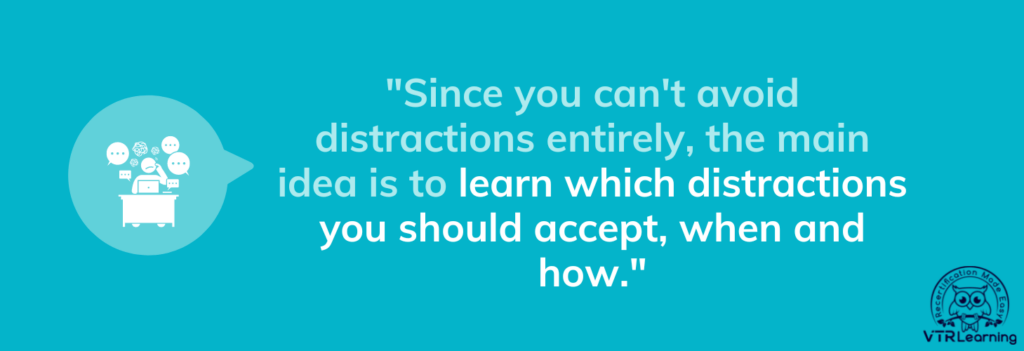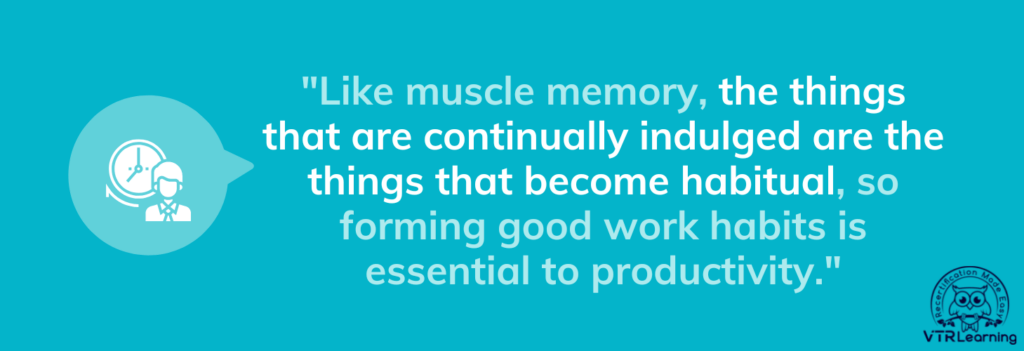![Tips for Managing Distraction [5 Helpful Tricks]](/wp-content/uploads/2021/04/Multitasking-Worker-Needs-Tips-for-Managing-Distraction.png)
In the wake of COVID-19, many business professionals have had the opportunity to work remotely. And while there are many benefits of working from home, there are also downsides, distraction chief among them. After all, when there are screaming children or a full sink of dishes, it can be difficult to focus. But let’s be honest – distraction isn’t just a problem when working from home. There are always talkative coworkers in the office. And what about getting up to grab that third cup of coffee? So, are we simply destined for distraction no matter the task or work environment, or are there ways of managing distraction? Of course, there are! Here are five tips for managing distraction, whether at home or in the office.
Here are Tips for Managing Distraction Effectively
1. Make a List of Priorities
Sometimes, the easiest method for managing distraction while working is simply to make a list of things that you need to do. After all, there’s something viscerally pleasing about being able to take a pen and mark through a completed task. It’s a physical signal that something, no matter how small, has been accomplished. But more than that, having a list to look at is a visual reminder that there are certain things that need to happen. And creating a list doesn’t have to be a big production.
Speaking from personal experience, whenever I begin my workday, I write down every task I need to complete. Then, when I begin and end those tasks, I mark down the time. This allows me to see how long I’ve actually spent doing certain things and keeps me on track throughout the day. But if you’re a person who prefers making digital lists, you might like Trello or Artful Agenda.
The trick to this tip, though, is learning to understand your limits. It’s easy to make a huge list and become discouraged when you haven’t finished everything at the end of the day. So, be conservative. It always feels better to add things, knowing you can get more done than you first thought, than it does to take things away.
2. Determine Breaks Ahead of Time
So far, the focus has been on managing distraction, and there’s a reason for that. In most cases, avoiding distraction is impossible, because no matter how hard you try, you can’t eliminate or control every potential obstruction. The idea, then, is learning which distractions to accept, when, and how. Because while you may not be able to control every instance of distraction, you can set up boundaries to have it on your terms.
You may not have a say whether the urge to check Facebook pops up in your mind mid-sentence while writing copy. But you can easily determine that you won’t check social media until you’ve completed a certain number of paragraphs. Of course, this means having a bit of self-control. Our bodies easily grow accustomed to certain stimuli, so that they become second nature. Often, whenever I’m working on something, I catch myself opening a new tab on my browser. And without thinking, I’m suddenly on YouTube. The catch to this tip is that we must train ourselves to be mindful of our actions. We have to understand when our minds are wandering and reign them back in. Again, the trick is to acknowledge distraction, then dictate if, when and how to accept it.

At the end of the day, how this happens depends on the individual. It can be task-based, where distractions are only indulged once certain items have been completed. But it can also be time-based. In that sense, an individual might set a time limit and work diligently throughout. Then, once that amount of time has elapsed, allow themselves to minutes of rest to check their email. Ultimately, this will vary from person to person.
3. Break Large Tasks into Smaller Ones
Discouragement and distraction go hand-in-hand. So, whenever a job seems too large to accomplish efficiently, the best thing to do is break it down into smaller, component tasks. These can be measured and completed individually to contribute to an overall sense of achievement. Of course, this is similar to the first of the tips for managing distraction, which was to create a list of tasks to accomplish. But here, the idea is that by focusing on each step in a process, it’s easy to set smaller goals to focus on.
For example, if a worker was building a shed, it would be nearly impossible to say, “Don’t get distracted while constructing this.” Because the task itself is too long. Instead, it might be better to say, “Complete the foundation, then you can take a break.” In this way, the worker has the opportunity to focus on completing one part of the process. Then, they can find time for a break. Structuring breaks in between component tasks gives something to look forward to, which can help focus on the task at hand. It’s easier to work efficiently and with focus when you know you’ll get a break. But if you have no idea when you’ll be able to rest, it’s more difficult to ignore the impulse in the moment.
4. Form Helpful Routines
Musicians and athletes probably recognize the term, “muscle memory.” It’s the idea that certain actions are repeated to a degree that they can eventually be accomplished without much thought. Daily routines and work schedules are like this as well, though mentally. Humans are, by nature, structured creatures. Despite what some say, we crave order, and without it we would fall apart. Even something as simple as a morning routine exemplifies this perfectly. Many people do the exact same things every day when they wake up, in mostly the same order. And when that routine is broken, they either create a new routine or settle back into the old one after things have quieted.
Part of avoiding distraction is forming daily work routines that help maintain focus. This doesn’t mean people should work mindlessly. But like muscle memory, the things that we continually indulge will eventually become habitual. So, if someone is used to checking Facebook every three minutes during the workday to see whether their post has gotten another “like”, that’s a distraction that can easily form into part of their daily routine. Forming good habits through intentional routine is at the heart of productivity.

Ultimately, this tip isn’t one which can be held in isolation from the others. In fact, the point is that it isn’t enough to do all these things for a single day. These tips for managing distraction all must become normalized, part of a daily routine. And in that sense, a person can become generally less distracted while working. It’s a conscious effort at first, but one which, with time, becomes more automatic. If an individual can intentionally refrain from checking their phone every few seconds, it will eventually feel normal, and they won’t think about doing so as often.
5. Remove External Distractions
It’s nice to believe that we all have immaculate self-control, that we can simply choose when to ignore a distraction. But that simply isn’t the case. That blinking light that signals a message on your phone will nag at the back of your mind until you check it. The television or podcast in the background might be keeping you from finding that word you need to make a sentence sound correct. And when all else fails, it can be helpful to remove the external distractions that vie for our attention. If the phone constantly rings, silence it or turn it off completely. If the background noise is too much, wear headphones and listen to some calming music.
It’s unrealistic to expect to minimalize or ignore every distraction. But we can take steps to remove the center of those distractions from our grasp long enough to work efficiently. Part of this even goes back to forming helpful routines. If you know you’re going to want a cup of coffee within the hour, and you haven’t started working, do that first. Minimize your chance of needing to get up for that drink. If it’s already sitting on your desk waiting for you, it’s far less a distraction than having to get up and make it when you’ve already begun working. So, this tip is twofold. 1) Take steps in your daily plan to head off distractions. And when that isn’t possible, 2) remove the cause of the distraction itself.
Find More Tips for Managing Distraction
Here’s the truth — it’s far easier to become distracted while doing something that isn’t entertaining. And typically, continuing education is boring, especially when it’s self-study. That usually means sitting through slide after slide of facts while some monotone voice drawls on endlessly over it. But with VTR Learning, we take a different approach. Ours entertains through narrative, story-based courses. So, if you’re a business professional looking for a way to keep from becoming completely distracted while taking continuing education, check out our courses. And why not try out these tips for managing distraction while you’re at it!
Last Updated:





![The Best Slack Integrations for HR Teams [5 Examples]](/wp-content/uploads/2019/08/5-Best-Slack-Integrations.png)